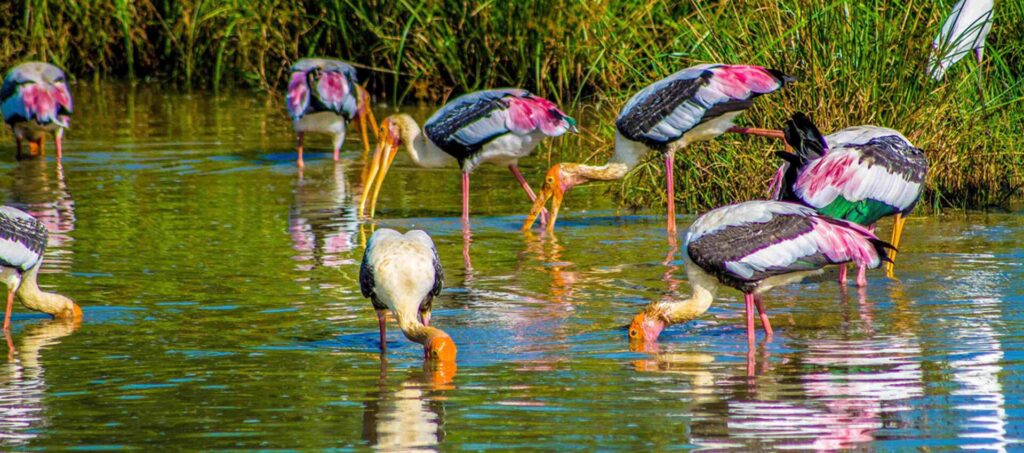Bundala & Tissa Wetlands
Sum up
Bundala & Tissa wetlands combine 20km of beach, lagoons and scrub hosting more than 150 bird species and should delight bird watchers in Sri Lanka. These wetlands are home to winter migratory birds and large flocks of flamingos. The lagoons are also popular with crocodiles. From October to January the park also receives visits from the endangered marine turtles that lay their eggs on the shore.
Duration: 3 hours
Best Time: October to March
Additional Information
The first Ramsar site in Sri Lanka – a wetland of international significance – Bundala National Park is a mix of scrub jungle and sand dunes bordering the sea. The park falls within the South-eastern Arid Zone of Sri Lanka, with a general climate that can be classified as hot and dry. The park consists of mainly dry thorny scabland and shallow, brackish lagoons which form a complex wetland system that harbours the rich bird life including several species of migratory birds. Just one of many unmissable parts of a birdwatching tour of Sri Lanka.
Flora & Fauna of the Bundala & Tissa Wetlands
The vegetation in the park can be categorized as terrestrial vegetation types and wetlands. The first type includes dry thorny scrubland, arid zone forests, sand dune vegetation, gentle seashore vegetation, maritime grasslands and Riverine forests. The wetlands consist of Salt marsh, Mangrove, Brackish water lagoons, water holes and tanks, seashore, streams and Salterns. A total of 383 species of plants have been recorded in Bundala. These consist of six endemic species and seven nationally threatened. The dominant large tree species are Weera, Neem, Palu, Kohomba and Divul. Andara is the dominant scrub.
Mammals
Viewing big game is not the best thing to do in Bundala. If one is very lucky, you will see an elephant or two. Other smaller mammals in this area include Spotted Deer, Wild Buffalo, the endemic Toque Macaque, Hanuman Langer, Jackal, Fishing cat, Rusty-spotted cat, Smabar, Porcupine, Indian Pangolin, Black-naped Hare and Wild Pig.
Birds
Endemic species include the Brown-capped Babbler, Sri Lanka Jungle Fowl and Sri Lanka Woodshirke. The large number of migrant birds comprises mainly of Golden Plovers, Kentish Plovers, Lesser and Large Sand Plovers, Marsh and Curlew Sandpipers, Common Greenshank, Common Redshank, Little Stints which are the common ones and the rarities include the Broad-billed Sandpiper, Ruff and the Bundala specialist Red-necked Phalarope. Bundala has long been popular for its frequent flock of Greater Flamingos seen during the migrant season. They were also recorded for a number of years to be resident and seen through out the year. Lately however, due to changes in the water quality of the lagoons and salterns, the Greater Flamingos have not been seen for a few years in their original numbers.
Many thousands of waterfowl like the Pintal, Gargany and Northern Shovelller ducks are also found in Bundala. Many species of forest birds that are seen in Yala are found here. Yellow-wattled Lapwing, Sirkeer Malkoha, Blue-faced Malkoha and Indian Silver-bill are some of them.
Many species of water birds are also now seen in Bundala and adjoining wetlands. Spot-billed Pelicans, all species of Egrets, Cormorants, Whistling Teal, Painted Storks, Asian Open-bills, Grey Heron and many other birds can be observed in large numbers. Bundala is also good for birds of prey.
Amphibians & Reptiles
Noteworthy amphibians include the endemic frog Bufo Athukoralei. The park is famous for its crocodiles also, including very large specimens of the Mugger Crocodile and the rare Estuarine Crocodile. Four species of Marine Turtles also come ashore to nest in the beaches of Bundala. The Hawksbill and Green turtle are the common species while the Olive Ridley and Leather-back Turtles are rare.
Access
From the A2 at the Weligatha junction, near the 251Km post, take the turn to the Bundala Village. The park office and entrance is on this road and there is a very good visitor centre here.
Popular Activities
Tissamaharama Sum up The serene and tranquil town of Tissa, short for Tissamaharama, was the capital of the ancient Ruhunu Kingdom in …
Bundala National Park Sum up Bundala National Park is one of the best places to for birdwatching in Sri Lanka, especially between …
Kalametiya Bird Sanctuary Sum up Kalametiya Bird Sanctuary is a beautiful, mellow spot with just you and a boatman punting a boat …
Kataragama Sum up The jungle shrine of Kataragama, located an hour’s drive away from Tissamaharama, has great religious and historical significance that …
Maligawila Buddha Statue Sum up The Maligawila statue, 15kms from Buttala, dates back to the 7th century BC. It is the largest …
Lunugamvehera National Park Sum up Lunugamvehera National Park, which lies between Yala and Uda Walawe, acts as an elephant corridor between the …
Uda Walawe Elephant Transit Home Sum up Visit the Elephant Transit Home in Udawalawe National Park, a rehabilitation centre for orphaned elephant …
Uda Walawe National Park Sum up Udawalawe, in Sri Lanka’s south-central sector, is the area that most resembles an African game park. …
Bundala & Tissa Wetlands Sum up Bundala & Tissa wetlands combine 20km of beach, lagoons and scrub hosting more than 150 bird …
















